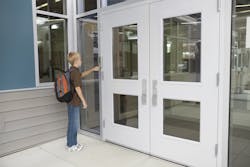Controlling access to a school generally begins at the front door — it is how most visitors enter a school (or an office, manufacturing facility or warehouse for that matter).
K-12 campuses have been among the best at adopting strategies to harden the front door (and other entries) with a repeatable and affordable plan that can fit most any facility. It involves assessments, layers of complimentary electronic security products and polices and procedures to make sure it all works.
Assessment
As with any security project, hardening the entries to control visitors begins with an all-hazards assessment by an experienced security consultant to determine risk at and surrounding the facility. That assessment should include the neighborhood and traffic patterns, lighting, landscaping, parking lots, windows, the rooftop, the front door and other entry points.
Bright lighting discourages criminals and helps patrolling first responders to have a better view of the campus at night. Lights need to illuminate the entire perimeter and parking lot; and they should be added at any outbuildings that might house expensive equipment.
Fencing and gates can help keep unwanted visitors from gaining access to the campus or facility, and they are also helpful in channeling legitimate visitors to the appropriate public entry. Signage provides to help guide visitors from the parking lot to the main entry. Signs can also explain what to expect during the entry process.
Landscaping also needs attention. Overgrown trees or shrubs can provide hiding places for contraband, and people looking to piggyback into campus buildings with approved visitors.
Access Control Assessment
It is important to learn how many people use each entrance and for what purpose. All of this information is critical to designing a security plan that fits the specific needs of each campus.
Using the typical K-12 campus as an example, there are likely five to six entries — the front door, two to three employee/staff entrances and another door or two for receiving daily deliveries of food, books and other school equipment. Unless in use, there is no reason from these doors to be unlocked — especially when children are present.
Employees and vendors aside, all visitors should enter through the front entrance. That’s where a “video doorbell” — a video intercom — becomes useful. Visitors push a button outside locked doors to request entry. Built-in cameras provide live video of the visitor on high-resolution, master-station monitors located within the office. These units also enable instant two-way audio communication typically with a receptionist or school resource officer.
Video intercoms can remotely open electronic locks — in a wired or network environment — to allow approved visitors to enter. If there is any doubt about the visitor’s intentions, the door remains locked and security or an SRO is called to intervene.
Many video intercoms feature wide-angle lenses with pan-tilt-and-zoom function. There are units that use coax or low voltage cable, while others require new or existing CAT-5e/6 network infrastructure and powered via PoE (Power over Ethernet).
Some also have built-in proximity card readers that allow access-card carrying staff, regular delivery personnel or screened volunteers to enter without bothering office personnel. Additional units can be surface- or flush-mounted at other entries.
Video intercoms are also useful on locked interior campus doors that protect records rooms, computer centers or other high-value areas. Used on these doors, the units can help keep school employees that have no business in an area from gaining entry.
Once in the front door, many schools have added a wall and another door to create an entry vestibule, one final barrier before gaining access to students or staff. Before exiting the vestibule visitors are required to present a government-issued photo ID card that is swiped through a visitor management system. That starts a check of the visitor’s credential against federal and state criminal databases and the national sex offender registry. Schools can add their own local information about non-custodial parents, disgruntled ex-employees and others that may be placed on an entry watch list.
The process does slow visitor entry by a minute or so, yet provides a much higher level of security. Most parents, volunteers and other visitors don’t mind that delay once they understand the reason for the process. Employees also appreciate the extra security. And each of these layers – electronic locks, video intercoms and visitor management systems – is among the most affordable tools available for integrators to include in a campus access control plan.
John Mosebar serves as vice president of marketing for Aiphone Corp. For more info about the company, please visit www.securityinfowatch.com/10212724.
About the Author

John Mosebar
Vice President of Marketing, Aiphone
John Mosebar serves as vice president of marketing for Aiphone. He is a 30-year veteran of the company, which is a leading manufacturer of security video intercoms. Mosebar's experience includes product management and business development with a focus on commercial, institutional, and government sales. Mosebar played a strong role in Aiphone's partnership with Tyco/ADT in their Education Security Solutions initiative. He is an active member of the American Society for Industrial Security (ASIS) as well as a member of the National Electrical Manufacturers Association (NEMA).
